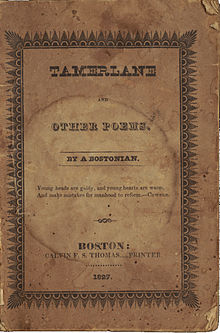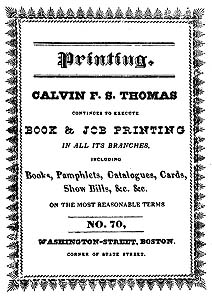Tamerlane and Other Poems
Tamerlane and Other Poems is the first published work by the American writer Edgar Allan Poe . The only 40-page volume of poetry was published in 1827. As far as is known, only twelve copies of the book exist today.
background
After a falling out with his foster father John Allan, Poe went to Boston , the place where he was born. One reason why he chose Boston was probably that his mother, Eliza Poe, had left him a watercolor of the city that she had painted, on the back of which it read:
“For my little son Edgar, so that he will always love Boston - the place he was born - and where his mother found her best and most compassionate friends . (For my little son Edgar, who should ever love Boston, the place of his birth, and where his mother found her best and most sympathetic friends ). "
Release history
In the spring of 1827, Poe gave his manuscript to an 18-year-old printer named Calvin FS Thomas. The contact may have come about because Poe's parents had known Thomas's parents. Otherwise Thomas only printed labels and leaflets; Tamerlane and Other Poems is the only proven book he has published. The volume appeared in the format 17.15 by 11.43 centimeters and cost twelve and a half cents. Poe paid for the publication. When the book appeared in June or July 1827, Poe was 18 years old. How many copies were printed is uncertain. Many researchers assume 50 copies, while others give numbers between 20 and 200.
Tamerlane and Other Poems appeared anonymously with the annotation "By a Bostonian" ("By a Bostonian"). The reason for this could either have been that Poe did not want his foster father to find out his whereabouts, or else Poe wanted to distance himself from Richmond and at the same time secure success in the important Boston book market.
The volume of poems was so poorly distributed that Rufus Wilmot Griswold was unable to locate it in 1850 and claimed that the book had never appeared. A first copy was found again in 1859, a second in 1874.
Subject

The poems in the volume show influences from Percy Bysshe Shelley , Samuel Taylor Coleridge and especially Lord Byron . Tamerlane, title character of the most important poem, has a daughter named Ada, probably named after Byron's daughter Ada Lovelace . Poe admired Byron's poetry as well as his adventurous life. Accordingly, after Poe's disappearance from Richmond, rumors circulated that he, like his role model Byron, had embarked and joined insurgents in Greece (the Greek Revolution was already history at the time).
The title poem Tamerlane refers to the historical figure of the Mongolian conqueror Tamerlane . It depicts a dying ruler who regrets having put ambition over love in his youth. Autobiographical elements in the poem suggest that Poe is processing the loss of his childhood sweetheart Sarah Elmira Royster and / or his mother . In addition, Poe, like the Tamerlane of the poem, was of uncertain origin and had a "wrong" name (namely Allan).
As Poe himself admitted, the following applies to the other poems in the volume:
"Taste a little too much like self-reflection, but they are written by someone who was still too young at the time to be able to draw his knowledge of the world from other sources than from his own heart."
One of the poems, Imitation , Poe later revised to A Dream Within a Dream , and elements of Evening Star can be found in Ulalume .
reception
At the time of its publication, Tamerlane and Other Poems did not meet with any critical response, neither positive nor negative. The volume was only mentioned in a few lists of new releases.
The literary scholar Joseph Wood Krutch called the volume in the 1920s "with a few poems the work of a beginner".
As far as is known, only twelve copies of Tamerlane and Other Poems still exist , making the volume one of the rarest first editions of American literature. Most of the copies are in the collections of libraries and museums. In December 2009, an original was auctioned for $ 662,500.
contents
In addition to a foreword, the volume contains ten poems in the following order:
- "Tamerlane"
- "To - -" (known as "Song")
- "Dreams"
- "Visits of the Dead" (known as "Spirits of the Dead")
- "Evening Star"
- "Imitation"
- Untitled poem (known as "Stanzas")
- Untitled poem (known as "A Dream")
- Untitled poem (known as "The Happiest Day")
- "The Lake"
literature
- William Bittner: Poe: A Biography. Boston 1962.
- Shelly Costa Bloomfield: The Everything Guide to Edgar Allan Poe: The Life, Times, and Work of a Tormented Genius. New York 2008, ISBN 978-1-59869-527-4 .
- Nicholas A. Basbanes: A Gentle Madness: Bibliophiles, Bibliomanes, and the Eternal Passion for Books. New York 1999, ISBN 0-8050-6176-2 .
- Joseph Wood Krutch: Edgar Allan Poe: A Study in Genius. New York 1926.
- Harry Lee Poe: Edgar Allan Poe: An Illustrated Companion to His Tell-Tale Stories. New York 2008, ISBN 978-1-4351-0469-3 .
- Kenneth Silverman : Edgar A. Poe: Mournful and Never-ending Remembrance. New York et al. 1991, ISBN 0-06-092331-8 .
- Dawn B. Sova: Edgar Allan Poe: A to Z. New York 2001, ISBN 0-8160-4161-X .
Web links
- List of known examples of Tamerlane and Other Poems. Edgar Allan Poe Society
- 1884 Tamerlane and Other Poems. at Google Books
Individual evidence
- ^ A b c Kenneth Silverman: Edgar A. Poe: Mournful and Never-Ending Remambrance. New York et al. 1991, ISBN 0-06-092331-8 , p. 38.
- ↑ Irwin Porges: Edgar Allan Poe , New York 1963, p. 64.
- ↑ EAPoe: works. Volume 4, Olten 1966, p. 782.
- ↑ Harry Lee Poe: Edgar Allan Poe: An Illustrated Companion to His Tell-Tale Stories. New York 2008, ISBN 978-1-4351-0469-3 , p. 34
- ↑ David Randall, David Anton: Dukedom Large Enough: Reminiscences of a Rare Book Dealer, 1929-1956 . New York 1969, p. 186.
- ↑ Shelly Costa Bloomfield: The Everything Guide to Edgar Allan Poe: The Life, Times, and Work of a Tormented Genius. New York 2008, ISBN 978-1-59869-527-4 , p. 39.
- ↑ Dawn B. Sova: Edgar Allan Poe: A to Z . New York 2001, ISBN 0-8160-4161-X , p. 253.
- ↑ Kay Cornelius: Biography of Edgar Allan Poe. In: Harold Bloom (Ed.): Bloom's BioCritiques: Edgar Allan Poe. Philadelphia 2002, ISBN 0-7910-6173-6 .
- ^ A b Kenneth Silverman: Edgar A. Poe: Mournful and Never-Ending Remambrance. New York et al. 1991, ISBN 0-06-092331-8 , p. 41.
- ↑ Harry Lee Poe: Edgar Allan Poe: An Illustrated Companion to His Tell-Tale Stories. Metro Books, New York 2008, ISBN 978-1-4351-0469-3 , p. 34.
- ^ Daniel Hoffman: Poe Poe Poe Poe Poe Poe Poe. Baton Rouge, 1972, ISBN 0-8071-2321-8 , p. 27.
- ↑ Dawn B. Sova: Edgar Allan Poe: A to Z . New York 2001, ISBN 0-8160-4161-X , p. 233.
- ↑ Kenneth Silverman: Edgar A. Poe: Mournful and Never-Ending Remambrance. New York et al. 1991, ISBN 0-06-092331-8 , p. 39.
- ^ Edgar: Preface to the edition of 1827 , trans. by Friedrich Polakovics, EA Poe: Works. Volume 4. Olten, 1966, p. 237.
- ^ Killis Campbell: Contemporary Opinions of Poe. In: The Mind of Poe and Other Studies. New York 1962, pp. 373-378.
- ↑ Joseph Wood Krutch: Edgar Allan Poe: A Study in Genius. New York 1926, p. 65.
- ↑ Lloyd Rose: Yo, Poe: In Richmond, A Museum Rises From The Dead. In: Washington Post. May 10, 1998.
- ^ Rare Edgar Allan Poe Book Sets New Auction Record.
- ^ Tamerlane and Other Poems at the Edgar Allan Poe Society

